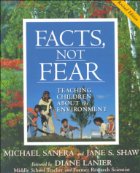 I reviewed this intriguing textbook (Facts, Not Fear: Teaching Children about the Environment) recently for LibraryThing. As the book originates with our own Alabama Policy Institute (formerly the Alabama Family Alliance), I thought the review might be worth repeating here. There’s nothing about the Alabama organization in the acknowledgments, but I found a magazine article in which AFA president Gary Palmer claimed responsibility for this book.
I reviewed this intriguing textbook (Facts, Not Fear: Teaching Children about the Environment) recently for LibraryThing. As the book originates with our own Alabama Policy Institute (formerly the Alabama Family Alliance), I thought the review might be worth repeating here. There’s nothing about the Alabama organization in the acknowledgments, but I found a magazine article in which AFA president Gary Palmer claimed responsibility for this book.
This textbook (for homeschoolers) poses as an antidote to biased, alarmist teaching about the environment, but its own bias is flagrant. It is valuable as a model of propaganda technique in general, and of anti-regulatory rhetorical strategies in particular. Its method mostly consists of amassing anecdotes, omitting unfriendly evidence (while preaching about respect for “science”), and keeping strict silence about topics that cannot be easily spun. There’s not a peep about toxic or nuclear waste, for instance, or about human health problems stemming from pollution.
The tykes whose parents use this book are likely to come away thinking that “garbage” consists entirely of household waste, and that industrial plants are just bigger versions of their own households. It follows, then, that petrochemical plants are just as concerned with keeping things neat and tidy as Mommy and Daddy are. And the biggest threats to the environment? Government regulation and public ownership of land, of course.
Despite the title, facts are rather sparse in this volume. Dogma, on the other hand, is most plenteous, and it’s tired dogma at that. The detailed index lacks many of the objective terms (like garbage, health, sludge, waste) that would seem to be essential to a text on environmental “facts.” Yet there are several entries for that snippet of libertarian dogma, the “tragedy of the commons,” plus quite a few one-sided discussions of controversial texts, from hoary old Malthus on population to Robert Jastrow, the dean of global warming skeptics. Consistent with good propaganda technique, the motivations of those scientists who uphold the “popular view” are never discussed. In fact, one is supposed to get the impression that all the real scientists agree with the authors — while the majority of the public supports environmentalism because they’re “emotional” and incapable of facing “facts.”
The only toxic compound I could find mentioned at all in this text was DDT, the first such compound in history to be restricted throughout the world banned in the United States. Weirdly enough, the authors attack the wisdom of regulating DDT, painting a ludicrous picture of the supposed evils that have resulted. Of course they pass over the recovery of America’s formerly endangered raptor population in silence. I suppose if they were forced to confront the fact that after DDT was restricted, bald eagles were again able to raise viable chicks, they would fall back on their “science-has-not-yet-determined” gambit. Then they’d unearth a study suggesting that maybe, just maybe, the eagles recovered because of a surge in American patriotism. (Skeptical? Why are you so closed-minded?) In order to be fair and to encourage “critical thinking,” both views must be presented to children as equally plausible. That’s what is meant by fact-based education.
Pardon my sarcasm. One of the consequences of living in a free society is that children cannot be fully protected from vicious or immoral speech, like this miserable book. It’s gratifying to see that my second-hand copy was apparently rejected with contempt by its previous owner. The postcards from the publisher are still inside, and the book appears never to have been used. My purchase of it benefited the Friends of the Library.
- Center for Media and Democracy, Facts, Not Fear wants to make the world safe for Styrofoam
- Christian home-schooling author Cathy Duffy deems the book “secular, but ‘Christian-friendly.’”
- Jim Norton, Fear of facts (info-pollution.com)
- Gary Palmer recycles the line “facts, not fear” in an opinion piece opposing environmental regulation.
- Property & Environment Research Center (“dedicated to improving environmental quality through markets and property rights”) promotes and sells Facts, Not Fear.
3 thoughts on “Facts, Not Fear: A study in fact-based falsehood”